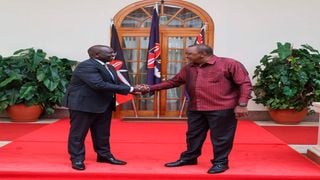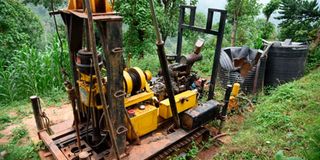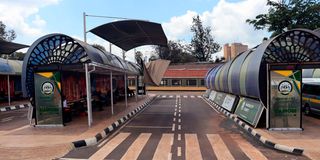
Former President Uhuru Kenyatta receives President William Ruto at State House, Nairobi on September 11, 2022.
| Courtesy | PSCUPolitics
Premium
Taxpayers’ heavy cost in Uhuru-Ruto fallout
The decision by President William Ruto to splash Sh1 billion on a digital identity database after a similar exercise under retired President Uhuru Kenyatta gobbled up at least Sh10 billion has laid bare the wastage of public funds due to political expediency.
Among the projects the Kenyatta administration initiated only to be abandoned by President Ruto after gobbling public funds include the new police uniforms and the controversial Huduma Namba.
Taxpayers are also set to lose money in the reconstitution of the Independent Electoral and Boundaries Commission selection panel and in a bid by Dr Ruto to revive the construction of scandal-ridden Arror and Kimwarer dam projects, which Mr Kenyatta cancelled on claims of corruption.
The planned demolition of the Sh1.9 billion Liwatoni floating bridge in Mombasa and scrapping of the Greenpark terminus in Nairobi will also lead to lossses for taxpayers.
On Tuesday, Immigration and Citizenship Principal Secretary Julius Bitok announced that the government would spend Sh1 billion to come up with Maisha Number. The new identity document is meant to replace the failed Huduma Namba that cost taxpayers in excess of Sh10 billion.
Police uniforms
"We've moved from the Huduma Namba to what we call the Maisha Number. The new number is a UPI and integrates all the databases from all the existing databases from civil registration and national registration," Mr Bitok said.
“We are all aware that there was another phantom project called Huduma Namba that was a complete fraud. We lost almost Sh15 billion and got very little out of it,” President Ruto said recently.
This decision comes barely weeks after the government started yet another process to replace police uniforms. The National Police Service (NPS) a fortnight ago unveiled a new uniform design, reviving memories of a political storm and claims of kickbacks that followed a similar exercise in 2018.
Then Interior Cabinet Secretary Fred Matiang’i accused unnamed individuals, who were presumed to be in then Deputy President Ruto’s political camp, of trying to influence the tender. He said the country was to save Sh700 million for making the uniforms locally, but the individuals he accused wanted them imported.
"What is happening here is that some people have put us under pressure that we should import police uniforms. We have to promote the local industry," said Dr Matiang’i.
In the run-up to the 2022 General Election, Dr Ruto vowed to reverse the decision should they ascend to power. Although they had promised to revert to the old uniform, the new administration has proposed a new one altogether with a huge cost implication in kitting all the officers in the country.
"You have suffered so much at the hands of [Dr] Matiang’i and [then Interior Principal Secretary Karanja] Kibicho. Even the new blue uniform, which you don't want, will be withdrawn and we will go back to the old one. The blue one will be left for the PCEA church. It is the uniform of the women's guild," Deputy President Rigathi Gachagua said during the campaigns.

Abandoned equipment at Kipsaiya in Elgeyo Marakwet where Aror dam was to be built. The Kimwarer and Arror dams projects are examples of kick-back-motivated projects that have saddled the taxpayer with expensive debts.
In the ongoing political standoff between Dr Ruto and Mr Odinga, taxpayers have been burning millions of shillings to keep the Independent Electoral and Boundaries Commission (IEBC) selection panel in office.
The National Dialogue Committee has indicated that it may consider reconstituting the panel, implying having a new team after the current one has spent millions of shillings doing nothing.
Agenda items
The talks team co-chaired by Wiper leader Kalonzo Musyoka and National Assembly Leader Kimani Ichung’wah has since formally written to the panel to “take note of the ongoing deliberations” at the Bomas of Kenya. Restructuring and reconstitution of IEBC is one of the agenda items for the talks.
“You never know; we may end up with the reconstitution of the panel itself,” said Mr Musyoka.
Mr Ichung’wah said: “We are not writing to them to stop them from doing their work. We are writing to [notify] them ... that we are having this conversation. They should take note that the issue of the reconstitution of the IEBC is one of the issues we are tackling.”
The team appointed by President Ruto has been in office since February, drawing allowances and perks for every sitting.
The seven-member team led by Dr Nelson Makanda has been pocketing a total of Sh180,000 every sitting, according to the Salaries and Remuneration Commission (SRC) rates applicable to panels and task forces appointed by the President.
According to the SRC rates, the chairperson is entitled to Sh30,000 as the six members get Sh25,000 each for every sitting, the technical head paid Sh10,000, with a clerical officer and security getting Sh4,000.
The figures translate to millions of taxpayers’ money, on top of other facilities extended to the members, including an office for the secretariat and a boardroom.
Other members of the panel are Bethuel Sugut, Novince Euralia Atieno, Charity S. Kisotu, Evans Misati James, Benson Ngugi Njeri and Fatuma Saman.
In March, President Ruto announced that Kenya and Italy had reached a deal to revive the construction of Kimwarer and Arror dams.
Mr Kenyatta had four years ago cancelled one of the dam projects and ordered the restructuring of the other.
The decision was informed by a report of a technical committee he had established to assess the viability of the dam projects.
Led by then Infrastructure Principal Secretary Paul Maringa, the team had returned a verdict in September 2019 citing Kimwarer dam as overpriced at Sh22.2 billion.
Ferry users crossing the Likioni channel at the Liwatoni Floating Bridge in Mombasa in this photo taken on 10th April 2021.
At the time of cancellation, over Sh19 billion had been paid, of which Sh11 billion was an upfront payment for insurance while Sh643 million had been allocated by the National Treasury for land compensation, but no land had been acquired.
More damning was that no current and reliable feasibility study had been conducted and that a 1991 study had shown geological faults that made the project unviable because the dam would have sat on a valley, requiring pumping of water supply at a high cost.
On Arror Dam, Mr Maringa’s committee found it to have been overpriced with Mr Kenyatta ordering a reduction of its height from 96 metres to 60 metres and cost from Sh28.3 billion to Sh15.4 billion.
Politically motivated
But Dr Ruto, who claims the move was politically motivated, has insisted the projects must proceed with an agreement to have cases withdrawn.
“We have agreed that financing already made available will be restructured. We plan to clear court issues in one month then have a conversation about restructuring on financing,” President Ruto said.
In July, Roads and Transport Cabinet Secretary Kipchumba Murkomen hinted at plans by the Kenya Kwanza government to demolish the Sh1.9 billion, 824-metre Liwatoni floating bridge. Built to ease congestion at the Likoni ferry, the bridge is used by pedestrians during the day and opened for ships to pass through at night.
During his tour of Mombasa City, Mr Murkomen argued that the bridge had led to congestion resulting in delays in clearance of goods.
His predecessor, Mr James Macharia, had in December 2020 said the bridge was only a temporary measure and would be brought down in 2025 once the Mombasa Gate Bridge is completed.

A tunnel along the Dongo Kundu Bypass. The Dongo Kundu Road cost taxpayers Sh220 million which was paid by KeNHA.
“We really want to do away with that bridge. It has created unnecessary congestion in our port. Discussions are ongoing to see if we should expedite the Dongo Kundu Road,” said Mr Murkomen.
The new regime is also planning to abandon plans to make use of the Sh250 million Green Park Terminus in Nairobi. Governor Johnson Sakaja in June said he would do away with the terminus and, in its stead, put up a world-class conference centre even with millions having been spent on the project.
Hailed as one of Mr Kenyatta’s legacy projects, the modern bus terminus was a brainchild of Nairobi Metropolitan Services (NMS) under the Executive Office of the President. It was aimed at decongesting the city centre.
However, Governor Sakaja is adamant the terminus will be flattened to pave way for the conference centre which will be built through a public-private-partnership initiative.
He said the terminus occupies a valuable five-acre parcel of land that can be converted for other uses.
In July, City Hall said it will not pay Sh15.1 billion in eligible pending bills left behind by the defunct NMS, pushing the debt to the Executive Office of the President.

Green Park Bus Terminus on May 4, 2023. The Nairobi County government plans to demolish the terminus estimated to have cost Sh250 million.
The Sh250 million pumped into the terminal project by the Lieutenant General Mohamed Badi-led entity is part of the billions worth of debt left behind by NMS at the end of its two-year tenure that taxpayers will have to service.
State House Comptroller Katoo Ole Metito said Sh411 million from the eligible pending bills has been paid with Sh200 million going to small claims court and Sh211 million to small merchants’ projects.
President Ruto has also abandoned the National Integrated Identity Management System, popularly known as Huduma Namba.
Kenya rolled out the mass distribution of the Huduma Namba card in 2019, which contained relevant information about an individual and was aimed at replacing the national identity card.
It would also enable individuals to access various government services as well as use it as a travel document within the East African region.






